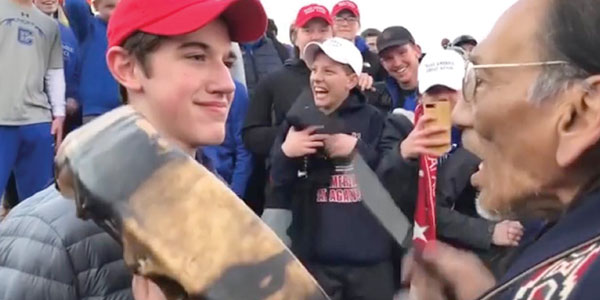
By Tere Siqueira
The “Make America Great Again” (MAGA) cap is at the center of controversy again.
The cap, which displays the slogan of President Trump’s 2016 election campaign, is seen being worn by students from Covington Catholic High School in a video taken during a January rally for indigenous people at the Lincoln Memorial in Washington, D.C. Specifically, the video shows a confrontation between Covington student Nicholas Sandmann and Nathan Phillips, a Native American elder and former Marine, with the two standing about a foot apart.
Since late January, the video has gone viral, sparking outrage, a school investigation and the denouncement of the students by the mayor of the town where Covington is located.
As The New York Times and other media outlets have reported, however, another video of the incident has emerged showing another perspective of the Sandmann-Phillips encounter. The second video shows a radical group of protesters known as the Black Hebrew Israelites taunting the teen and other Covington students, who were in Washington for another rally, by shouting obscenities about the Catholic Church. According to the Detroit Free Press, Phillips claimed he was intervening in the Covington-Black Hebrew Israelites verbal fight when the confrontation with Sandmann resulted.
Since Trump’s election campaign, the MAGA cap has become a source of controversy because many Americans view it as a symbol of intolerance and hate. Hip-hop artist Kanye West is among those who have drawn ire for wearing the cap and referencing it in his music. Recently, a California restaurant owner stated that customers wearing MAGA caps would not be served.
In late January, Washington Post fashion critic Robin Givhan discussed how interpretations of the MAGA cap have changed over the past few years. Talking with Michel Martin on National Public Radio, Givhan said the cap was originally a symbol of “sort of innocuous political swag.” But it was then “kidnapped, weaponized by Charlottesville and by white supremacists and by the violence that went on in some of those rallies (like Charlottesville) by a minority of people at those rallies,” she said.
Gorra de MAGA en el centro de video polémico y viral
La gorra de “Make America Great Again” (MAGA) está en el centro de la controversia nuevamente.
La gorra, que muestra el eslogan de la campaña electoral del presidente Trump del 2016, fue usada por los estudiantes de la preparatoria católica Covington en un video tomado en enero durante una protesta de indígenas en el Lincoln Memorial en Washington, D.C. El video muestra un confrontación entre el estudiante de Covington, Nicholas Sandmann y Nathan Phillips, un anciano nativo americano y veterano, con los dos parados a un pie de distancia.
Desde finales de enero, el video se volvió viral, lo que provocó indignación, una investigación escolar y la denuncia de los estudiantes por parte del alcalde de la ciudad donde se encuentra Covington.
Sin embargo, como informaron The New York Times y otros medios de comunicación, surgió otro video del incidente que muestra otra perspectiva del encuentro Sandmann-Phillips. El segundo video muestra a un grupo radical de manifestantes conocidos como los israelitas hebreos negros burlándose de los adolescentes y otros estudiantes de Covington, que se encontraban en Washington para otra manifestación, gritando obscenidades sobre la Iglesia Católica. De acuerdo al Detroit Free Press, Phillips afirmó que estaba interviniendo en la batalla verbal entre los israelíes hebreos negros y Covington cuando se produjo el enfrentamiento con Sandmann.
Desde la campaña electoral de Trump, el límite de MAGA se ha convertido en una fuente de controversia porque muchos estadounidenses lo ven como un símbolo de la intolerancia y el odio. El artista de hip-hop Kanye West se encuentra entre los que se han sentido atraídos por usar la gorra y hacer referencia a ella en su música. Recientemente, un propietario de un restaurante de California declaró que los clientes que usan gorras MAGA no serían atendidos.
A finales de enero, el crítico de moda del Washington Post, Robin Givhan, habló sobre cómo han cambiado las interpretaciones de la gorra de MAGA en los últimos años. Hablando con Michel Martin en la Radio Pública Nacional, Givhan dijo que la gorra era un símbolo de “de moda política inofensiva”. Pero luego fue “secuestrada, armada por Charlottesville y por los supremacistas blancos y por la violencia que siguió por una minoría de personas en algunas de esas protestas”, añadió.









